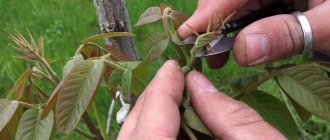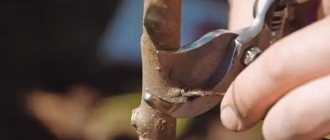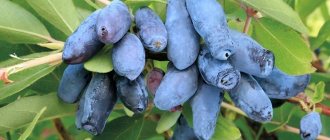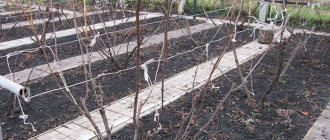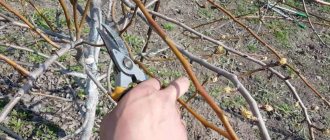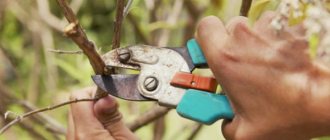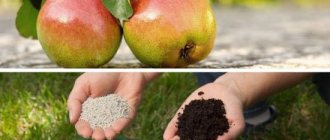Principles of pear pruning
This procedure is carried out in order to thin out the crown, since this tree is very sun-loving. Periodic cutting off young shoots allows the tree to devote all its strength to the existing strong branches, and therefore to the fruits.
In addition, if the pear is not pruned, then picking fruits from such a tree will be very inconvenient. Gardeners often wonder: how to prune a pear tree correctly?
There are a number of rules for properly pruning a pear tree:
- Pruning needs to be done annually.
- Correctly form the height of the trunk in the first year of the seedling’s life: at least 60, but not more than 90 centimeters.
- Prune vertical branches in all seasons, as these are parasitic branches.
- When pruning, the crown should be made as transparent as possible so that the fruits receive more sunlight and ripen faster.
- Follow the rule of subordination: strong shoots should be located at the bottom, weak ones at the top.
- Skeletal branches growing upward should be cut to the outer bud (half a centimeter away from the tree bud).
- Shoots located next to the guide or on the side branches should be cut into three to five buds or cut out completely.
- Branches need to be cut to a side shoot, and not to a ring, to prevent the formation of parasitic branches (tops).
Pear diseases
To save the crop and tree from diseases, it is necessary to carry out preventive treatments of the garden in a timely manner.
Scab
– the disease develops in the spring and is manifested by the appearance of a greenish-brown coating on the foliage. Damaged leaves fall off over time.
Fruit rot
– grayish-brown circles of rot on the fruit. The spores of this disease are carried by the wind and can infect trees growing nearby.
Rust
– a fungal disease that appears on the outside of leaves in the form of rust-like spots.
Powdery mildew
– the disease affects shoots, buds, inflorescences, leaves. The disease manifests itself by the appearance of a dirty white coating, from which black spots are formed as a result.
Today, many different varieties of pears have been developed thanks to the work of breeders.
Types of pruning
Depending on the type of pruning, there are:
- sanitary, consists of removing dry, frozen or diseased branches;
- thinning. The purpose of pruning is to remove tops and branches growing inside the crown;
- shaping, carried out to give shape to the crown of the tree;
- stimulating, this is the shortening of side shoots;
- rejuvenating, carried out with the aim of extending the life of the pear.
Purposes of pruning and its types
Pruning a pear tree can solve many problems.
The main ones include:
- Cleaning the crown from frozen, broken branches;
- Pruning improperly growing shoots;
- Crown lightening;
- Removing diseased branches;
- Crown formation;
- Limiting upward growth;
- Providing harvest for next year;
- Stimulating the growth of side shoots.
Thanks to timely pruning, a beautiful tree is formed that does not shade other crops growing in the garden.
Based on the purposes of the procedure, the following types of pear pruning are distinguished:
- Sanitary is used to remove broken, dry branches. It is based on cutting off diseased shoots and inspecting the tree for problem areas.
- Formative is carried out on a young plant in its first years of life. A correctly formed crown improves the quantity and quality of fruits and allows you to achieve a certain structure that makes working with the tree easier. The crown of the pear should be shaped like a pyramid.
- Thinning provides air exchange for the crown, brightens its space by removing part of the shoots that grow deeper and intersect.
- Stimulating in the form of shortening shoots. This pruning limits the upward growth of branches and improves lateral branching. During the procedure, from 1/3 to 1/6 of the length of the shoots is cut off.
- Rejuvenating prolongs the life of the tree and improves productivity. To do this, part of the old wood is cut out, which leads to the growth of new branches. The procedure is performed in autumn or early spring, until active sap flow begins.
Sanitation can be carried out at any time, with the exception of the winter months. It is better to practice the pear shape in its third year of life. To do this, branches growing towards the outer bud are cut in half. The next year, the side shoots that grow upward are removed. A tree placed in a horizontal position begins to bear fruit faster.
Spring pruning of pear
Pruning of pears in spring begins when the air temperature rises to five degrees Celsius and frosts are left behind. Before starting work, and upon completion, it is necessary to disinfect the pruning shears and hacksaw.
First, thin out the crown, shorten the conductor by one quarter so that the tree does not grow too much upward. Remove all vertical shoots.
If necessary, provide support to horizontal branches. All cut areas must be lubricated with garden varnish, oil paint, drying oil or Rannet.
How to prune a young pear in the spring after planting
Representatives of the culture are prone to thickening the crown. Many varieties are characterized by high growth vigor with low activity in relation to the formation of fruiting shoots. This leads to the fact that the tree annually grows with twigs directed vertically upward, which do not “want” to actively branch.
Such growth does not form fruit branches for a long time, therefore pears that are not subjected to timely processing begin to bear fruit late and are not able to realize the potential laid down by breeders.
Pruning a pear in the spring after planting is the first time in the life of a young tree and is necessary in order to give the root system time to develop and recover. Until the underground part of the plant gets stronger, it is better to “slow down” the full development of the above-ground part.
The operation is carried out immediately after the seedling takes its place on the site. How to shape a pear after planting depends on its age and the degree of branching of the trunk:
- Standards without side branches are cut to 50–80 cm in height from the grafting site.
- Well-formed seedlings require full processing. The side branches are cut to 0.3–0.5 lengths; the larger the shoot, the larger the size of the removed twig. The central conductor should protrude 20–25 cm above their level. During the procedure, up to 5 buds can be removed from each process.
The result of processing a well-formed seedling should be a tree with 4 lateral shoots or less. They will become the basis of the future crown, skeletal branches of the first order. You can trim both the outer and inner buds.
How to prune a pear if the branches grow upward
The skeletal branches of the future pear should be formed at an angle no sharper than 60–65 degrees. If the shoot deviates too much from this value up or down, it is removed, leaving a 0.5 cm shoot at the bud.
Trees of the crop are prone to the formation of tops, vertically growing non-fruitful shoots. Fighting them is difficult, but necessary to obtain a full harvest.
There are several basic ways to handle such branches:
- Ring cutting is an effective method of fighting tops, but in the spring it cannot be used to form the crown of pears. By autumn, the tree will grow several of these shoots from one nest, which will only complicate the situation.
- Pinching barely emerging shoots during spring and summer prevents the formation of full-fledged tops, but requires constant attention to the tree and time.
- Cultivation of tops involves pruning them annually in such a way as to include the resulting shoots in the fruiting process.
“Taming” tops is the best way to form the crown of seedlings.
Pruning a pear tree in the spring will not be difficult for beginners if you use a convenient scheme for its implementation.
Pruning pears in summer and autumn
Summer pruning of pears involves pinching. In summer, the pear is not pruned, but only pinched. This process is called pinching and involves removing the upper part of the young shoot, which improves sap flow of the tree. You can pinch with your hands, or you can use scissors or pruning shears. Pinching takes much longer than trimming, but is worth it.
It is best to carry out pinching at the end of July or beginning of August. Beginning gardeners should know that pear trees are pruned in summer only if they have many young shoots that the tree needs to be removed.
The last pruning of the year is carried out in the fall to prepare the tree for frost. You can start pruning at the end of August, the main thing is to do it before the air temperature drops to 0o.
First, you should trim the branches that grow horizontally from the trunk. Then, vertical branches. Be sure to treat the cut areas.
How to care for pears after pruning
First of all, after pruning the pear, you need to close all the wounds with garden varnish or paint over them with oil paint.
The next stage of care: in the fall, remove all the fruits from the tree and in the area under the tree, then loosen the ground. Next, you should organize abundant watering three weeks before the onset of autumn frosts.
In order for the pear to survive the winter cold, watering must be carried out. Pour 2 buckets of warm water under each tree.
It is useful if you first dissolve potassium permanganate crystals in water and then pour it on. Potassium permanganate will destroy colonies of larvae that are going to overwinter in the roots.
The next stage of care is fertilizing after watering. What fertilizers will be useful for pears:
- potassium sulfate;
- double or regular superphosphate;
- monopotassium phosphate;
- wood ash;
- bone flour.
Fertilizer solutions should be poured around the tree trunk, but not at the root. It’s good if you spray the tree with potassium monophosphate in the fall. It’s a good idea to coat the trunk with lime with the addition of copper sulfate. To prevent the whitewash from flying around, you can add PVA glue to it.
During the winter, it is recommended to protect not only young seedlings, but also mature trees from rodents. To do this, the trunk is bandaged with spunbond or burlap so that the bark breathes and does not dry out.
The final stage. You need to put mulch under the pear. This can be humus, compost or a mixture of peat and sawdust. The thickness of the mulch depends on the “crackiness” of frost in the region.
Pruning a young tree
After planting the seedling, it is necessary to trim the conductor of the young pear so that it does not become too tall in the future. Ideally, the tree should be no more than 60 centimeters in height.
- Side branches should be trimmed to 10-15 centimeters, above the buds. Also, pinch off the buds located closer to the ground so that the tree does not waste its strength on them.
- In the second year, continue the formation of the crown by trimming the side branches, leaving only three with an interval of 10-20 centimeters.
- In the third year, three branches of the second tier should be left, the rest should be cut off, and the conductor should be cut off. In the fourth year, it is necessary to form the third tier of branches in a similar way. Every spring, dry and lifeless branches should be removed.
Types of pruning
The purposes and methods of pruning determine its type. At different periods of vegetation development and at a specific age, the tree needs certain care.
For young pears, it is necessary to correctly form the crown skeleton. Mature fruit-bearing trees need pruning, which will allow the incoming nutrients to be evenly distributed. Old trees need rejuvenating pruning.
Sanitary
With this pruning, dry and disease-affected shoots, as well as those that have been mechanically damaged, are removed from trees. First, the tree is inspected and areas that require removal are identified. Damage and affected areas of the crown can be removed throughout the season, and in the fall a sanitary procedure is mandatory.
Formative
In the first few years after planting, pear trees undergo formative pruning. Its goal is to form a complete pear skeleton, which further determines the longevity of the tree, the quality and stability of the harvest. Also, the correct shape makes it easy to care for the tree.
Scheme of correct and irregular formative pruning
It is better to form the crown in the spring. In the fall, it is worth assessing the length of the growth and you can slightly adjust the tree skeleton formed over the year.
Thinning
The pear differs from other fruit trees in its intensive shoot growth. To prevent the development of diseases, it is necessary to ensure sufficient ventilation and lighting of the central part of the crown. Excess shoots create an unfavorable shadow for the formation and ripening of fruits.
When thinning the crown, thickening branches are removed. These include tops, shoots that grow downwards or deeper, as well as those that cross each other.
Stimulating
To slow down the growth of shoots or branches, they must be shortened in a timely manner. This operation stimulates lateral branching and improves the quality of the crop. The branches are shortened by a third or less (up to ⅙ part, depending on the length of the annual growth).
Rejuvenating
As the tree ages, the yield of the tree decreases. To restore and maintain abundant fruiting, it is necessary to remove old wood.
Scheme of rejuvenating tree pruning
The procedure is carried out carefully and in several stages. Removing a large part of the branches in one season puts the tree under serious stress, which negatively affects its immunity. It is recommended to take a break of 1-2 years between serious prunings.
Caring for an old pear
For an old pear, a rejuvenation procedure will be necessary, which is carried out not in one season, but over several years. The essence of rejuvenation is pruning old skeletal branches so that new ones grow.
You can trim only one third of the total crown mass at a time. First of all, it is necessary to remove branches with signs of disease, freezing, as well as dry branches.
Remove branches growing parallel to the crown and tops. Process the cut areas. For several years after rejuvenation, the pear may not bear fruit, but then the result will exceed all expectations.
Why does pear need pruning?
The pear must undergo a pruning procedure. There are several reasons for this:
- First of all, you need to thin out the crown. The dense crown prevents light from reaching all the branches on the tree, and the pear is a very sun-loving plant.
- Pruning is needed so that more nutrition from the roots goes to the fruits, and not to unnecessary branches.
- It is difficult to collect fruits from a tall and spreading tree; it is impossible to keep track of whether pests have attacked it.
- It is not easy to treat a dense crown from diseases and pests.
- A spreading tree takes up a lot of space, preventing vegetable crops planted nearby from growing. The crown blocks the sunlight, and at the end of summer it fills the beds with unsightly-looking fruits.
- The inability to carry out sanitary pruning, which can lead to the spread of diseases to the entire tree.
To avoid all troubles, the pear tree needs pruning.
Shaping the pear crown
The process of forming a tree crown lasts several seasons. It should be started the next year after planting. The seedling needs to be cut to 80 centimeters to create a sparsely tiered form.
In the second year, cut off all shoots to a height of 50 centimeters from the ground. Leave three side branches and a conductor; cut off the remaining branches so that their length does not exceed 60 centimeters. In the third year, if necessary, shorten the skeletal branches.
The formation of a spindle-shaped crown is very common, since this crown shape promotes early and good fruiting.
Using the garter method, semi-skeletal branches are given a horizontal position. To prevent the lower branches from drooping, their length should be no more than one and a half meters.
To form a cup-shaped shape, in the first year you need to cut off the conductor. Leave three or four main branches evenly spaced around the circumference of the trunk.
The semi-flat shape is used when there is not enough space for wood. As a rule, the pear is planted near the fence. The branches grow parallel to the ground, just on the sides of the tree. Tiers are formed over several seasons by trimming excess branches.
When is the best time to prune a pear tree: autumn, spring or summer
You can prune a tree that is dormant: before or after the growing season, that is, in autumn or spring. After the procedure, the pear should have time to heal its wounds.
Benefits of autumn pruning:
- facilitating care in the spring and summer (especially in cases when spring comes quickly), recurrent frosts in the spring slow down wound healing;
- the end of the growing season will not allow new shoots to form this year;
- Proper pruning will increase yields next season;
- slowing down the flow of sap facilitates the healing of cuts.
Correctly carried out pruning will increase the yield in the next season. Autumn pruning is relevant for areas where winter comes late and passes mildly, since in a harsh climate the pruned branches freeze slightly. Otherwise, trees should be pruned in the spring before sap flow begins.
Photo of pear tree pruning
Trimming scheme
If we talk about the scheme for pruning a pear after planting, then the whole process will depend on the specific pruning method. The most popular is sparsely tiered. But recently, many gardeners prefer the improved-tier method. It is a special type of crown in which the tree has more skeletal branches. The formation principle is as follows:
- In the first year, the pole is cut at approximately a height of 80 cm; if the plant has not reached this mark, no shortening is carried out.
- The first tier of skeletal branches is formed. But if with the sparse-tiered method they are left in the amount of 2-3, then with the improved method the number of such shoots is 3-4 branches.
- Future skeletal branches are shortened by about a third.
- The pruning areas are treated with an antiseptic.
It is important not to damage the tree and bark too much in the process. If this happens or any branch breaks off, then it is carefully trimmed and the area is covered with garden varnish or paint.
In the process of pruning “tops”, damaged or crooked, diseased shoots, it is important to do this carefully and “on the ring”. Stumps cannot be left, as well as deep “wounds”, otherwise the seedling will take too long to recover and the juices will not be used to form the root system, but to heal the cuts.
Why prune a pear tree?
Pear seedlings in general are most often sold at 1-2 years of age; this is one of the most critical periods in the formation of the future crown of the tree. The manipulation will allow:
- Improve the condition of the cortex, strengthen it.
- Form the correct growth of skeletal branches.
- Improve the lighting level of the tree.
- Bring the fruiting period closer.
- Prevent the development of diseases transmitted by parasites living in cracks in the bark.
- Accelerate the process of development of the root system, which will help the plant adapt faster.
- Give the tree the most optimal height and shape.
Accordingly, the entire process should be carried out as responsibly as possible and taking into account a number of nuances. Only a planted pear is a fairly susceptible tree, and therefore, with the right approach, there is a chance to increase the plant’s chances of survival and accelerated fruiting.
Calculate
In our company you can order a tree pruning service from 800 rubles.
To calculate the cost of services, fill out the form or call us at:
+7,
Pruning an adult plant
Pruning of an adult neglected pear is carried out gradually, over several years. The timing is not important; such work can be done throughout the growing season and even in winter in the southern regions of the country.
You need to get to work by first preparing a running tree. It is necessary to organize proper nutrition: remove weeds, apply increased doses of fertilizers.
Begin pear pruning by removing the top of the tree. This technique allows you to lighten the center of the tree. Then they begin sanitary pruning, cleaning the crown of the pear, and removing:
- old dry branches;
- weak, diseased branches;
- intersecting branches;
- long and thin bare branches;
- tops and other non-fruiting shoots.
A significant reduction in green mass with a constant number of roots leads to improved nutrition of the remaining crown. Correct cutting:
- improves illumination and improves photosynthesis;
- the height of the tree is reduced, which allows the harvest to be fully harvested;
- increases the number of young shoots and leaves;
- the crop moves from the periphery throughout the crown evenly;
- the size and taste of the fruits noticeably increase and improve.
Important! Branches are trimmed without leaving stumps, which will rot over time. They are cut down along a clearly visible ring located at the base of the branches.
Large branches are first trimmed from below, then they begin to saw from above. In this case, the branch does not break off when sawing and does not tear the bark.
Branch cuts larger than 1.5 cm in diameter must be covered with natural drying oil or a special garden product after the cut has dried.
Spring pruning
In the spring, novice gardeners face a headache - how to prune a pear? This procedure should be started early in the spring - in March, early April. Spring weather means you no longer have to worry about branches freezing due to wounds that appear after pruning.
Important! Early spring pruning stimulates branch growth.
Proper pruning of pears in spring begins with sanitary pruning. Cut out first:
- dry and broken branches;
- poorly developed, weak, with traces of disease or damage;
- if the branches grow unsuccessfully: crossed, closely growing parallel, competitive, growing inside the crown;
- tops.
And finally, they begin anti-aging pruning, which allows you to get the maximum number of flower buds.
To prune a pear in the spring, you need to wait until the temperature is above zero during the day and there is no frost at night. It is important to have time to carry out this operation before the kidneys awaken.
Important! It is convenient to prune a pear in the spring - the location of all branches is clearly visible, each branch is easy to reach.
Simply assess the condition of the crown, the degree of its development, and the need for correction. Feeding pears after pruning in the spring is a mandatory procedure. After all, pruning gives good results only in combination with other work: watering, fertilizing, protection.
Summer pruning
In summer, pruning is more gentle and has other tasks. During summer pruning, the operation is designed to solve the following problems:
- set the correct direction for the growth of young shoots;
- adjust the number of ovaries;
- direct the main flow of nutrients not to the growth of green mass, but to the growth of set fruits;
- prevent the tree from “fatten” and grow unnecessary branches;
- increased growth of roots and skeletal branches.
Important! Summer pruning retards branch growth.
Summer pruning is gentle; it is advisable not to cut out branches, but to pinch (pinch) the tops of growing shoots. In May and until mid-July, young shoots that have grown by 15 cm are pinched.
They perform “blinding” of the bud—removing a bud that may grow into an unwanted shoot. This procedure is a real garden art. A gardener, like a true grandmaster, is able to calculate in advance the direction of growth of a future branch and the benefit or harm of its presence on the tree.
Important! The advantage of summer pruning is the rapid overgrowth of all cuts and the growth of new branches.
Disadvantage: overgrown foliage makes it difficult to see the whole picture and makes it difficult to find branches that need to be removed.
Feeding and watering the pear abundantly after summer pruning is just as necessary as during the spring operation.
Autumn pruning
The task of autumn pruning is sanitary. By this time, the number of regrown branches is maximum. Pruning begins immediately after leaf fall. And the entire crown, just like in the spring, is clearly visible.
You can see areas with dense, overgrown branches, bark with traces of disease, lesions, broken, immature and weak branches. In order for the pear to grow strong and resilient, such places must be completely cut out.
Important! The advantages of autumn pruning are the ability to fully assess the condition of the pear, its development and fruiting.
The disadvantage is the risk of frostbite on cut branches. After all, the wounds do not heal well at this time, although they are covered with garden varnish. Therefore, there is no point in delaying the mandatory autumn pruning.
Important! Autumn pruning regulates the number of branches.
In the southern regions of the country, pear trees can be pruned in winter. A tree in a dormant state easily tolerates all operations. The wounds do not cause damage, there is no infection at this time, the tree does not lose leaves or bleed sap.
Of course, you shouldn’t cut out large branches at this time, but it’s time to remove tops and other blind shoots without flower buds. The presence of tops indicates a slowdown in the growth of lateral branches.
The main condition for successful winter intervention is that the temperature outside should not fall below -15 degrees. The best time for winter pruning is February.
Recommended deadlines for work in the fall
In the fall, it is best to choose a clear, sunny day for pruning so that there are at least three weeks left before the onset of frost.
An indicator of the possibility of pruning is the tree shedding its leaves. At this time, the plant begins to prepare for winter, and the movement of sap in its tissues practically stops. An important condition for choosing the time is the average daily temperature not lower than +8°C. The timing depends on the climate of the region.
| Region | Recommended timing | |
| Early varieties | Mid-season and late varieties | |
| Middle zone and Moscow region | From late August to mid September | From mid-September to the first ten days of October |
| Siberia and the Urals | From 5 to 15 September | Mid to late September |
| Leningrad region | From the first ten days of September to the first days of October | First ten days of October |
| South | Mid to late October | First ten days of November |
According to the lunar calendar of 2022, the most favorable dates for pruning are:
- September 1, 6, 7, 15, 16, 26–28;
- October 2–5, 12–13, 25, 29–31;
- November 4, 5, 9, 10, 25–28.
If frost suddenly comes to the region, it is better to postpone pruning until spring. At sub-zero temperatures, wounds on the tree will not have time to heal and will become a gateway for infection to penetrate the tissue.
Trimming Features
In general, pruning a pear after planting does not require any special skills. It is important to consider the following factors:
- Properly selected garden tools, which should be sharp and clean;
- Availability of antiseptic for processing sections;
- Choosing the time of year for the formation of the pear crown after planting;
- Plant variety.
- Selecting a removal scheme.
The latter is especially important to determine before starting work, since the number and method of cutting branches will depend on it. This will also affect the life of the tree and its fruiting in the future. For low-growing varieties, for example, a spindle-shaped crown molding is more applicable, but for tall trees a sparsely-tiered crown is considered best.
